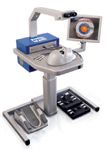Article
Surgical simulator tool stimulates surgery
An ophthalmic surgical simulator improved residents' operating room performance during phacoemulsification and improved patient outcomes.

Residents who used the simulator had significantly lower mean phacoemulsification time, mean phacoemulsification power used, and mean adjusted phacoemulsification time compared with residents who did not use the simulator.
"[We believe] this study was the first to provide evidence that the use of a surgical simulator in ophthalmology training actually can improve operative performance," said Dr. Belyea, vice chairman, Department of Ophthalmology, and director, Glaucoma Service, The George Washington University Medical Center, Washington, DC.

The complications were graded from 1 to 4 as follows: grade 1, endothelial basement membrane tear or detachment; grade 2, anterior or posterior chamber capsular tear without vitreous loss; grade 3, anterior or posterior chamber dehiscence with vitreous loss and sulcus lens placement; and grade 4, anterior chamber lens placement and vitrectomy, according to Dr. Belyea.
The residents performed a total of 592 cataract surgeries. Of these, 286 cases were performed by residents who were randomized to the simulator and 306 by those not randomly assigned to the simulator.
The residents randomly assigned to the simulator performed significantly better compared with the non-simulator group.
"Student's t-test comparisons showed that there was a statistically significant difference between the simulator and non-simulator groups for the mean phacoemulsification time (1.88 minutes; range, 0.11 to 7.20 compared with 2.41 minutes; range, 0.04 to 8.33, respectively; p < 0.002); for the mean phacoemulsification power used (25.32%; range, 2.2 to 50.0 compared with 28.19%; range, 8.0 to 70.0; p < 0.0001); and for the mean adjusted phacoemulsification time (47.58 seconds; range, 0.24 to 280.80 compared with 71.85 seconds; range, 0.32 to 583.10; p < 0.0001).
Newsletter
Don’t miss out—get Ophthalmology Times updates on the latest clinical advancements and expert interviews, straight to your inbox.





